publications
2024
-
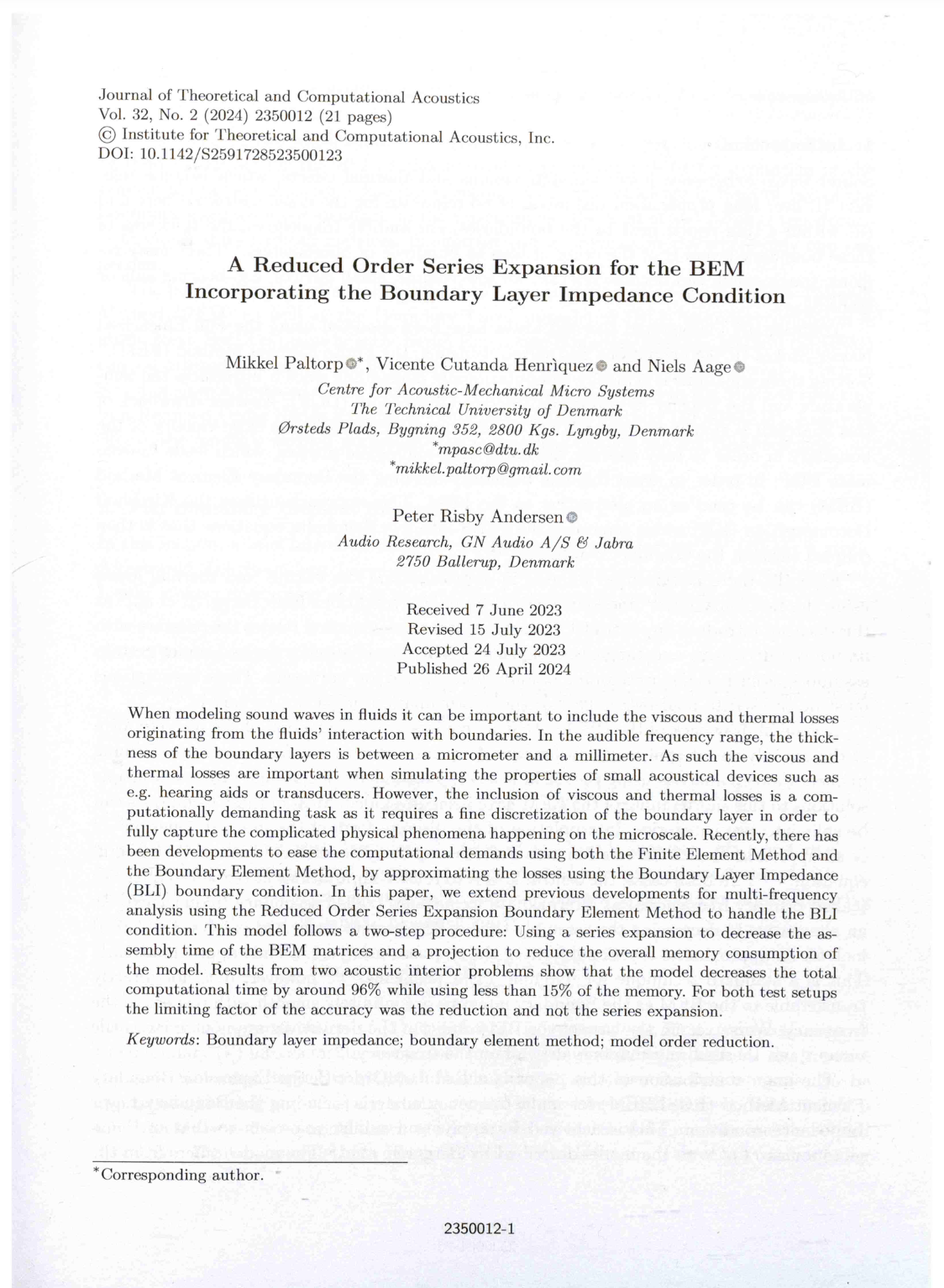 A Reduced Order Series Expansion for the BEM Incorporating the Boundary Layer Impedance ConditionMikkel Paltorp, Vicente Cutanda Henriquez, Niels Aage, and Peter Risby AndersenJournal of Theoretical and Computational Acoustics, 2024
A Reduced Order Series Expansion for the BEM Incorporating the Boundary Layer Impedance ConditionMikkel Paltorp, Vicente Cutanda Henriquez, Niels Aage, and Peter Risby AndersenJournal of Theoretical and Computational Acoustics, 2024When modeling sound waves in fluids it can be important to include the viscous and thermal losses originating from the fluids’ interaction with boundaries. In the audible frequency range, the thickness of the boundary layers is between a micrometer and a millimeter. As such the viscous and thermal losses are important when simulating the properties of small acoustical devices such as e.g. hearing aids or transducers. However, the inclusion of viscous and thermal losses is a computationally demanding task as it requires a fine discretization of the boundary layer in order to fully capture the complicated physical phenomena happening on the microscale. Recently, there has been developments to ease the computational demands using both the Finite Element Method and the Boundary Element Method, by approximating the losses using the Boundary Layer Impedance (BLI) boundary condition. In this paper, we extend previous developments for multi-frequency analysis using the Reduced Order Series Expansion Boundary Element Method to handle the BLI condition. This model follows a two-step procedure: Using a series expansion to decrease the assembly time of the BEM matrices and a projection to reduce the overall memory consumption of the model. Results from two acoustic interior problems show that the model decreases the total computational time by around 96% while using less than 15% of the memory. For both test setups the limiting factor of the accuracy was the reduction and not the series expansion.
2023
-
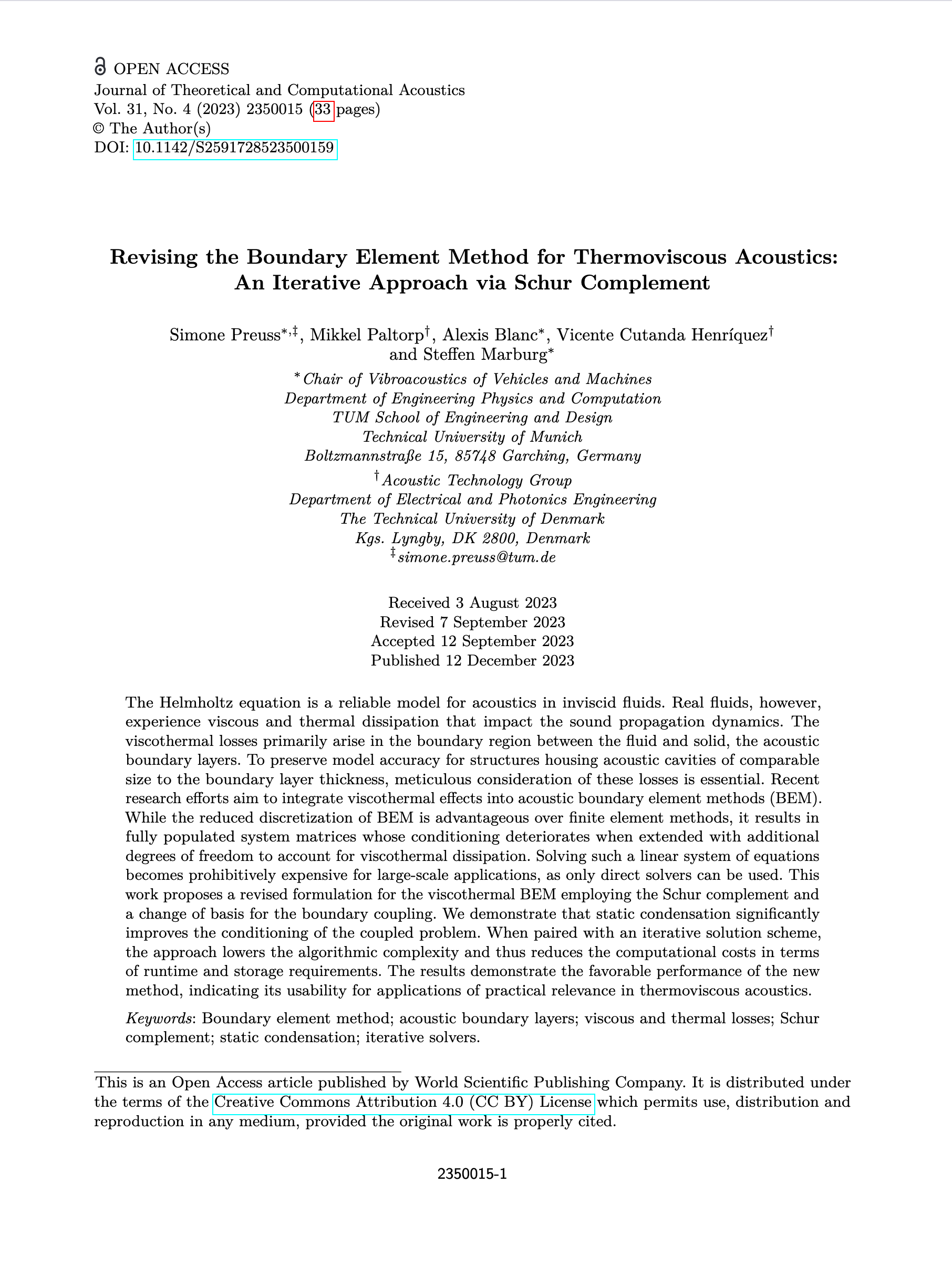 Revising the Boundary Element Method for Thermoviscous Acoustics: An Iterative Approach via Schur ComplementSimone Preuss, Mikkel Paltorp, Alexis Blanc, Vicente Cutanda Henrı́quez, and Steffen MarburgJournal of Theoretical and Computational Acoustics, 2023
Revising the Boundary Element Method for Thermoviscous Acoustics: An Iterative Approach via Schur ComplementSimone Preuss, Mikkel Paltorp, Alexis Blanc, Vicente Cutanda Henrı́quez, and Steffen MarburgJournal of Theoretical and Computational Acoustics, 2023The Helmholtz equation is a reliable model for acoustics in inviscid fluids. Real fluids, however, experience viscous and thermal dissipation that impact the sound propagation dynamics. The viscothermal losses primarily arise in the boundary region between the fluid and solid, the acoustic boundary layers. To preserve model accuracy for structures housing acoustic cavities of comparable size to the boundary layer thickness, meticulous consideration of these losses is essential. Recent research efforts aim to integrate viscothermal effects into acoustic boundary element methods (BEM). While the reduced discretization of BEM is advantageous over finite element methods, it results in fully populated system matrices whose conditioning deteriorates when extended with additional degrees of freedom to account for viscothermal dissipation. Solving such a linear system of equations becomes prohibitively expensive for large-scale applications, as only direct solvers can be used. This work proposes a revised formulation for the viscothermal BEM employing the Schur complement and a change of basis for the boundary coupling. We demonstrate that static condensation significantly improves the conditioning of the coupled problem. When paired with an iterative solution scheme, the approach lowers the algorithmic complexity and thus reduces the computational costs in terms of runtime and storage requirements. The results demonstrate the favorable performance of the new method, indicating its usability for applications of practical relevance in thermoviscous acoustics.
-
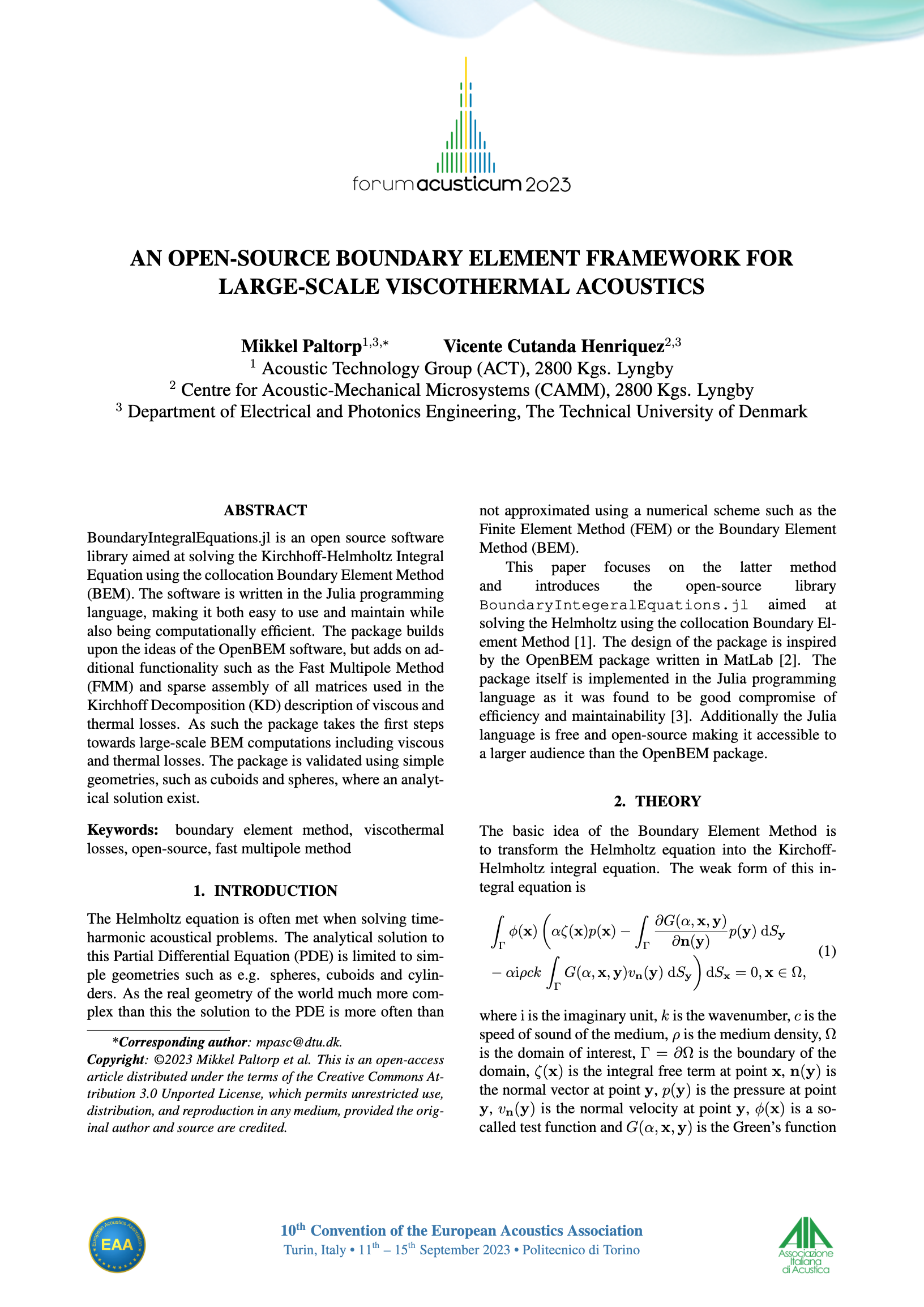 An open-source Boundary Element framework for large-scale viscothermal acousticsMikkel Paltorp and Vicente Cutanda HenriquezIn Proceedings of the 10th Convention of the European Acoustics Association Forum Acusticum 2023, 2023
An open-source Boundary Element framework for large-scale viscothermal acousticsMikkel Paltorp and Vicente Cutanda HenriquezIn Proceedings of the 10th Convention of the European Acoustics Association Forum Acusticum 2023, 2023BoundaryIntegralEquations.jl is an open source software library aimed at solving the Kirchhoff-Helmholtz Integral Equation using the collocation Boundary Element Method (BEM). The software is written in the Julia programming language, making it both easy to use and maintain while also being computationally efficient. The package builds upon the ideas of the OpenBEM software, but adds on additional functionality such as the Fast Multipole Method (FMM) and sparse assembly of all matrices used in the Kirchhoff Decomposition (KD) description of viscous and thermal losses. As such the package takes the first steps towards large-scale BEM computations including viscous and thermal losses. The package is validated using simple geometries, such as cuboids and spheres, where an analytical solution exist.
-
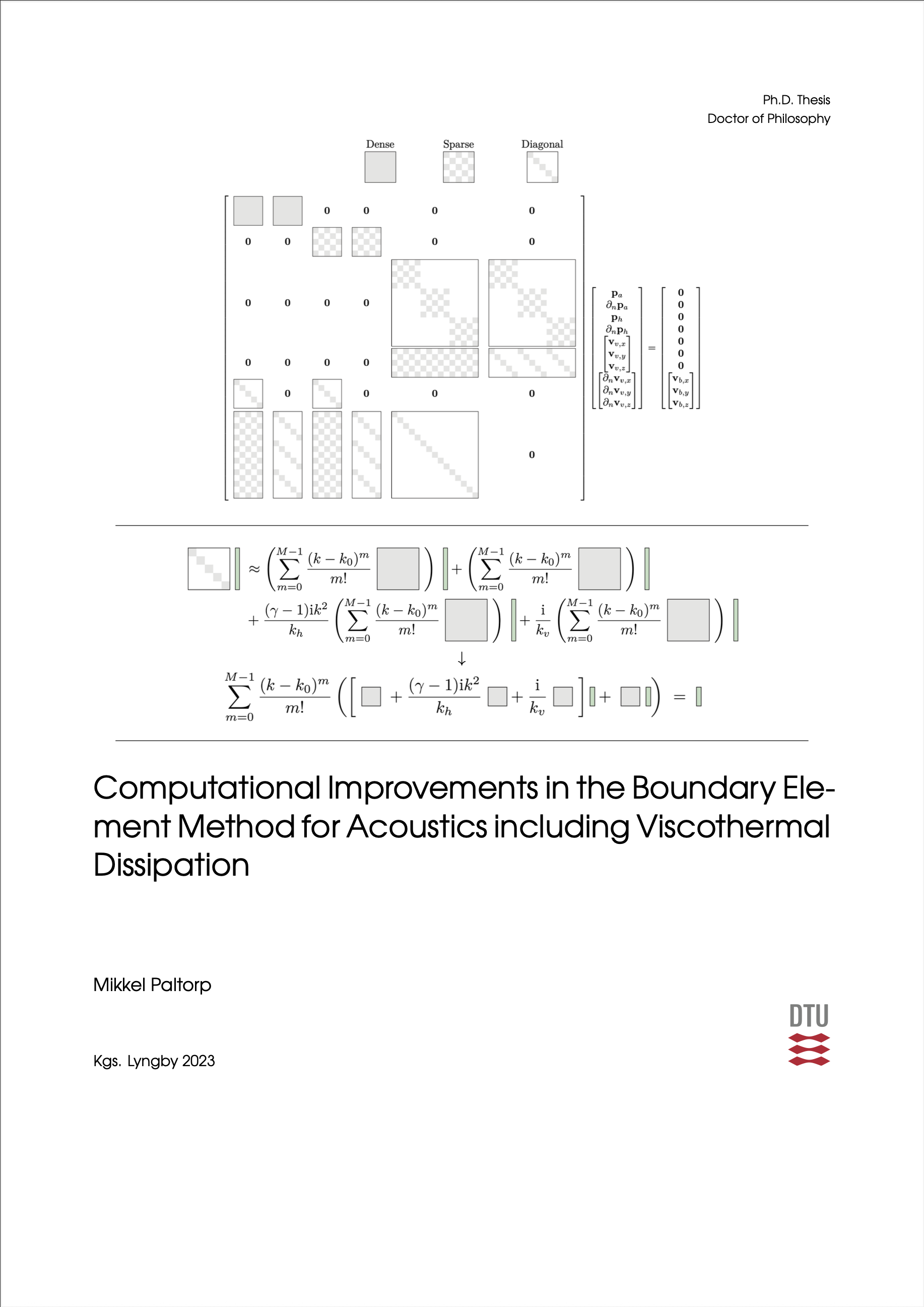 Computational Improvements in the Boundary Element Method for Acoustics including Viscothermal DissipationMikkel Paltorp2023
Computational Improvements in the Boundary Element Method for Acoustics including Viscothermal DissipationMikkel Paltorp2023"A long range of problems in acoustical engineering necessitate the incorporation of both viscous and thermal dissipation in order accurately capture the real-world physics. These dissipative effects become particularly important when dealing with smaller geometrical dimensions in the acoustic domain, as seen in applications like acoustic transducers and hearing aids. The computational technique known as the boundary element method offers the ability to account for dissipation while avoiding the need for boundary layer meshing. This is opposed to the widely used finite element method for which boundary layer meshing is a must. In addition, the boundary element method is suitable for modeling unbounded domains, which is often of interest in acoustical modeling. However, the current formulation of the boundary element method including viscous and thermal losses, has two notable drawbacks. The first major limitation is the reliance on frequency-dependent boundary integrals, which makes the formulation unsuitable for scenarios involving multiple frequencies. The second major limitation is that the formulation depends on both sparse and dense matrices, each of which comes with its own problems. Although sparsity is most often associated with pleasantries in numerical analysis, the current formulation cannot utilize its properties to the fullest. In fact, the solution stage includes a series of sparse matrix-matrix products which cannot be guaranteed to be sparse, which in turn ruins the computational advantage that is usually contributed to sparsity. The dense matrices is a different beast and would instantly render the formulation unusable for large-scale problems. However, in the context of boundary element matrices, there exist ways to approximate the matrix-vector products of these types of matrices in a way that scales. The key is to then reformulate the problem in a way for which only the matrix-vector product is required. Solutions to the two issues at hand have been developed within the context of pure acoustical problems. This thesis extends the solutions in the context of viscous and thermal losses. In particular the multifrequency problem is resolved by extending a known reduced order series expansion boundary element method to include the boundary layer impedance boundary condition. This development required the derivation of the Taylor expansion of the tangential derivative of the Green’s function. The resulting model is more complex than the original due to the frequency-dependent coefficients in front of the integrals stemming from the boundary layer impedance condition. The solution in the context of large-scale simulations is a two-step process. The first step is an extensive reformulation of the underlying model that allows one to utilize the sparsity patterns of the so-called thermal and viscous modes in the solution phase. This was a necessary first step in the direction of large-scale simulation, as without this it would have not made sense to continue with this formulation. The final step was then to reformulate the problem in a way for which only the dense matrix-vector product with the so-called acoustical mode was required. Given this reformulation, it was then possible to approximate the matrix-vector product using standard techniques such as the fast multipole method or H-matrices. Using these, it was possible to solve problems of sizes far beyond what was previously possible. "
2022
-
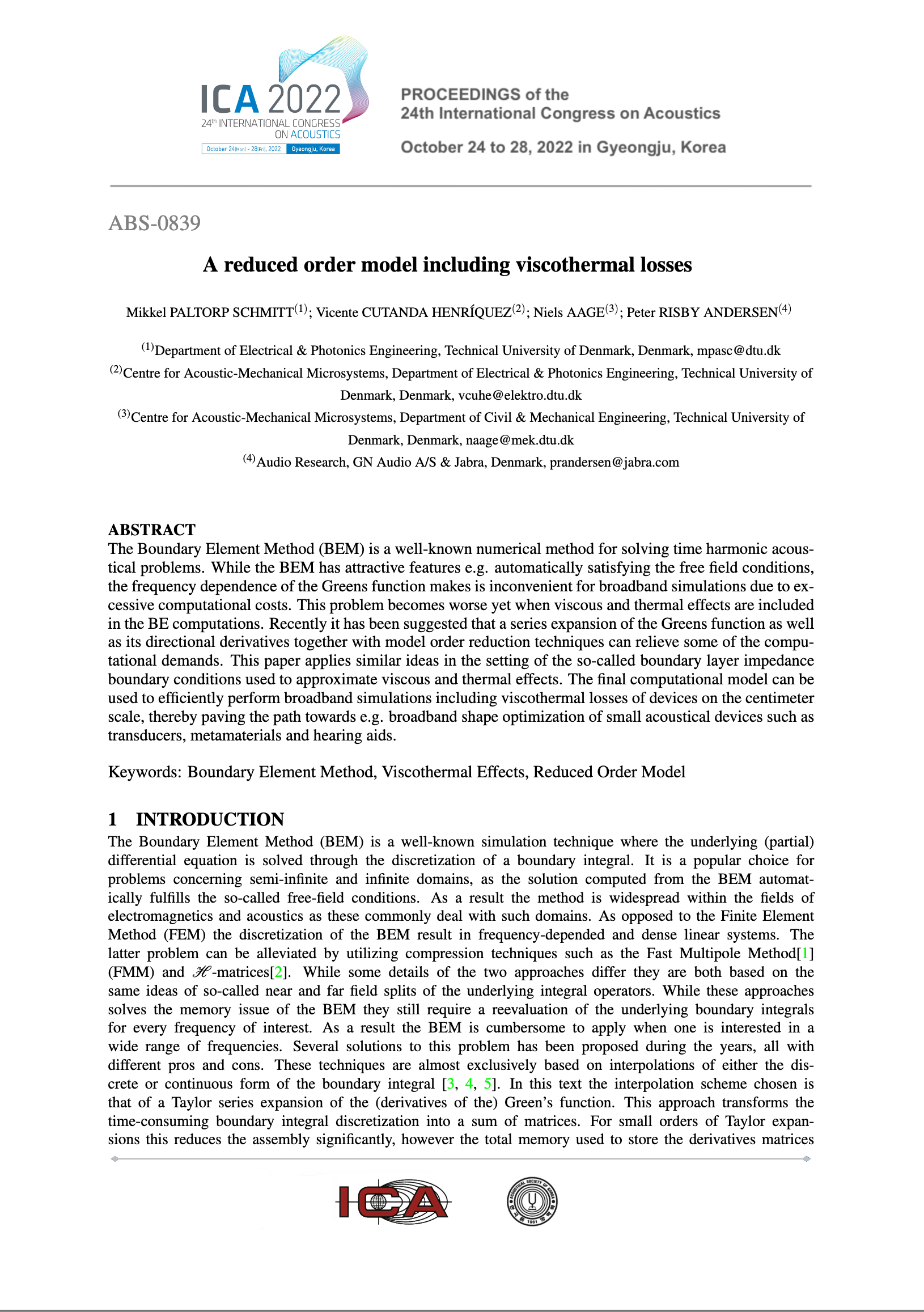 A reduced order model including viscothermal lossesMikkel Paltorp, Vicente Cutanda Henriquez, Niels Aage, and Peter Risby AndersenIn Proceedings of 24th International Congress on Acoustics, 202224th International Congress on Acoustics, ICA 2022 ; Conference date: 24-10-2022 Through 28-10-2022
A reduced order model including viscothermal lossesMikkel Paltorp, Vicente Cutanda Henriquez, Niels Aage, and Peter Risby AndersenIn Proceedings of 24th International Congress on Acoustics, 202224th International Congress on Acoustics, ICA 2022 ; Conference date: 24-10-2022 Through 28-10-2022The Boundary Element Method (BEM) is a well-known numerical method for solving time harmonic acoustical problems. While the BEM has attractive features e.g. automatically satisfying the free field conditions, the frequency dependence of the Greens function makes is inconvenient for broadband simulations due to excessive computational costs. This problem becomes worse yet when viscous and thermal effects are included in the BE computations. Recently it has been suggested that a series expansion of the Greens function as well as its directional derivatives together with model order reduction techniques can relieve some of the computational demands. This paper applies similar ideas in the setting of the so-called boundary layer impedance boundary conditions used to approximate viscous and thermal effects. The final computational model can be used to efficiently perform broadband simulations including viscothermal losses of devices on the centimeter scale, thereby paving the path towards e.g. broadband shape optimization of small acoustical devices such as transducers, metamaterials and hearing aids.
